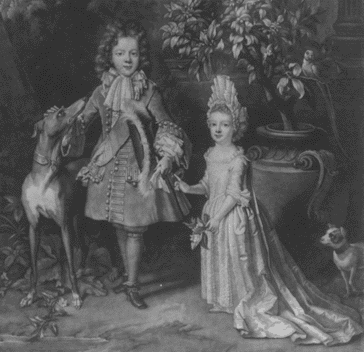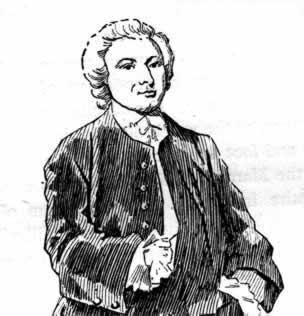The Leading Local Jacobites
 The most prominent local Jacobite was James Radcliffe, 3rd Earl of Derwentwater, a Northumbrian nobleman of the top league. He was an illegitimate grandson of Charles II on his mother's side, and had huge estates (and wealth) in Northumberland and Cumberland from Berwick to Alston. His loyalty to the Stuarts was undisputed.
The most prominent local Jacobite was James Radcliffe, 3rd Earl of Derwentwater, a Northumbrian nobleman of the top league. He was an illegitimate grandson of Charles II on his mother's side, and had huge estates (and wealth) in Northumberland and Cumberland from Berwick to Alston. His loyalty to the Stuarts was undisputed.
With his brother Francis, he had been sent to the court of Saint-Germain in 1702 to be a boyhood companion to James Francis Edward (James III). The boys become firm friends, and James Radcliffe became, like his ancestors, an ardent Catholic. His first attempt to help restore James Stuart to the throne occurred during the failed invasion of 1708, when he was unlucky enough to be captured in a French ship. In 1709 he decided to settle on his estates in Northumberland, which he had never seen. His return gave Jacobite activities in the area a huge boost. He very quickly developed a wide range of friendships among the Catholic and High Anglican gentry of Northumberland, Durham, Cumberland and Lancashire, and he became popular for his kindness, courtesy and hospitality. Behind this jovial facade, however, the Earl was working constantly to promote the cause of his cousin, James Stuart. Under cover of games of bowls and horse races at local pubs and houses, a strong network of Jacobite connections was soon built up around the Earl and his younger brother, Charles. As yet, however, the Jacobites had high hopes that James Stuart might be nominated as Anne's successor and thus come to the throne by constitutional means, so there was little real plotting. In 1712 Derwentwater married a Catholic heiress, Anna Maria Webb, a devoted supporter of the exiled Stuarts.
In 1709 he decided to settle on his estates in Northumberland, which he had never seen. His return gave Jacobite activities in the area a huge boost. He very quickly developed a wide range of friendships among the Catholic and High Anglican gentry of Northumberland, Durham, Cumberland and Lancashire, and he became popular for his kindness, courtesy and hospitality. Behind this jovial facade, however, the Earl was working constantly to promote the cause of his cousin, James Stuart. Under cover of games of bowls and horse races at local pubs and houses, a strong network of Jacobite connections was soon built up around the Earl and his younger brother, Charles. As yet, however, the Jacobites had high hopes that James Stuart might be nominated as Anne's successor and thus come to the throne by constitutional means, so there was little real plotting. In 1712 Derwentwater married a Catholic heiress, Anna Maria Webb, a devoted supporter of the exiled Stuarts. Another key local Jacobite was William, 4th Baron Widdrington. He too had spent much of his youth at Saint-Germain. He lived at Stella on the Tyne, had extensive mining interests and was at the centre of the region's Catholic community. Both Derwentwater and Widdrington had large extended families of co-religionists across Northumberland and Durham. Other important Catholic Jacobite families were the Haggerstons, the Swinburnes of Capheaton and the Erringtons of Beaufront. The Catholic families of Northumberland and Durham represented a wealthy and powerful force with considerable influence, and all favoured the cause of James III.
Another key local Jacobite was William, 4th Baron Widdrington. He too had spent much of his youth at Saint-Germain. He lived at Stella on the Tyne, had extensive mining interests and was at the centre of the region's Catholic community. Both Derwentwater and Widdrington had large extended families of co-religionists across Northumberland and Durham. Other important Catholic Jacobite families were the Haggerstons, the Swinburnes of Capheaton and the Erringtons of Beaufront. The Catholic families of Northumberland and Durham represented a wealthy and powerful force with considerable influence, and all favoured the cause of James III. Not all of the local Jacobites were Catholics. Two of the local MPs, William Blackett of Newcastle and Thomas Forster of Bamburgh, were deeply involved in Jacobite plots. Thomas Forster was a nephew of Bishop Crewe and came from an important Northumbrian family, who held a parliamentary seat. The Forsters had gambled away a large fortune and it was only Crewe's intervention that saved the family from disaster. Thomas Forster was a High Anglican and Tory, and he believed that many Tories could be persuaded to come over to the Jacobite side once a rebellion had begun.
Not all of the local Jacobites were Catholics. Two of the local MPs, William Blackett of Newcastle and Thomas Forster of Bamburgh, were deeply involved in Jacobite plots. Thomas Forster was a nephew of Bishop Crewe and came from an important Northumbrian family, who held a parliamentary seat. The Forsters had gambled away a large fortune and it was only Crewe's intervention that saved the family from disaster. Thomas Forster was a High Anglican and Tory, and he believed that many Tories could be persuaded to come over to the Jacobite side once a rebellion had begun.
William Blackett was a successful Newcastle merchant who had bought Wallington from another Jacobite family, the Fenwicks. He was a Tory and was also a secret Jacobite. Being a successful member of the mercantile community, it was hoped he would be able to bring over the political establishment of Newcastle. These men were the ring leaders of Jacobite activities in Northumberland and Durham and were to be key players in the Rising of 1715.